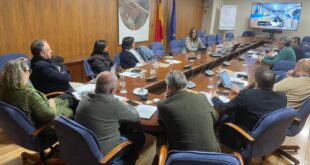![]() By Nina Shapiro
By Nina Shapiro
Seattle Times staff reporter
[slideshow_deploy id=’90145′]
The imposing brick building has long ceased being a Sephardic synagogue. But Stars of David still occupy a prominent space on the doors and above the windows of the Tolliver Temple Memorial Church of God in Christ, at East Fir Street and 20th Avenue.
Cameras came out as roughly 50 people from around the world – including Spain, Argentina, Brazil, England, Turkey, Greece, Mexico and several U.S. cities – stopped to look on a Tuesday morning walking tour.
The ground they covered was narrow: six blocks along Fir. But this slice of the Central District looms large in the history of Seattle’s Jews, Howard Droker, who coauthored a book about that history, “Family of Strangers,” told the group.
Several synagogues once stood here, and those attending would head after services to Yesler Way, where they would stroll up and down saying hello, passing Jewish-owned grocery stores and coffee shops that doubled as venues for playing backgammon and smoking hookah.
Those on the tour are participating in a biennial conference called Erensya, which brings together Sephardic Jews, descended from people expelled from Spain and Portugal during the Inquisition and settling largely in the Ottoman empire. Continuing through Friday and sponsored by a Spanish-government organization, the conference is taking place in an English-speaking community for the first time.
“Symbolically it’s very significant,” said Devin Naar, a University of Washington associate professor who leads a thriving Sephardic studies program. “It represents Seattle’s emergence as a kind of Sephardic hub.”
The metropolitan area has the third largest Sephardic community in U.S., after New York and Los Angeles. It numbers about 5,000 people – 8 percent of the region’s Jewish population, according to a 2014 survey by the Jewish Federation of Greater Seattle.
Many of the Sephardim, like the area’s Jewish population as a whole, stand apart from any denomination. Seattle’s two Sephardic synagogues – Sephardic Bikur Holim and Congregation Ezra Bessaroth, both now in Seward Park – have about 500 families combined, and they are considering merging.
Yet, there are signs of vitality that impress Erensya delegates. Michael Black of London was struck by a talk given by 23-year-old Ethan Marcus, who is working to get local millennials involved with the Sephardic community. Marcus spoke about a recent Friday night Shabbat dinner for young people, and a group that meets every other week with Naar to learn Ladino, the once-prevalent language of the Sephardim.
Also intrigued, Liliana Benveniste, who with her husband runs an organization in Buenos Aires that teaches Ladino, said she would like her students to come here to meet with Naar’s.
On Wednesday, conference attendees will visit the UW’s Sephardic studies program, where they will hear about a project to be unveiled at an event on Sunday. Naar has just completed digitizing a vast collection of Ladino books and documents – the largest in the U.S., he says, and one that will challenge a misperception that little literature or intellectual life existed in Ladino.
Nearly all the material came from Seattle families. “What I’m trying to figure out is why this didn’t happen in New York,” Naar said, hinting at a special energy giving the local Sephardic community an importance beyond its size.
Doreen Alhadeff has certainly worked to make it so. Belonging to a prominent Sephardic family, the 68-year-old in 2016 became the first American to take advantage of a program offering Spanish citizenship to the descendants of those once expelled.
She also lived in Madrid a few years ago to help organize an Erensya conference held there. She lobbied to bring the next one to Seattle, and lost out to Mexico City. Finally, she got her way.
Recognizing the challenges of dwindling synagogue membership, she said, “what we’re really looking to do is pull the community together.” Erensya, she added, opens the door to new ideas from other communities, like a big festival held in New York by Sephardim with roots in what is now Greece.
Monday night, the conference held an event open to the public: an exhibit of a new travelling collection of artifacts from a Jewish museum in Rhodes. The Greek island, once part of the Ottoman Empire, and then Italy, was the birthplace of many Sephardic immigrants to Seattle.
Congregation Ezra Bessaroth, founded by those immigrants, housed the exhibit and a talk by museum founder Aron Hasson, who lives in Los Angeles. Around 200 people attended, twice as many as expected.
They saw an intricately designed ketubba, or marriage contract, from 1852; decorative clogs of the sort worn by women at Turkish baths or ritual ones before a wedding; and documents from World War II attesting to discrimination against Jews and their eventual deportation to Auschwitz.
Regina Amira lingered over a silver container called a “kucharera,” rimmed by attached spoons and forks. “My mother had a set like this,” said the 87-year-old, who left Rhodes with her family when she was 7. She showed how they’d take a spoon off and dip it into the container, filled with preserves and passed around when guests came.
“Look at this,” enthused Sylvia Azose Angel, 75, delighted by the turnout to the exhibit. “It means a lot to me. It’s part of my family history.”
Fuente: seattletimes.com
 eSefarad Noticias del Mundo Sefaradi
eSefarad Noticias del Mundo Sefaradi

